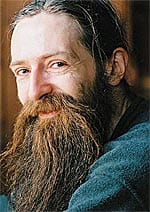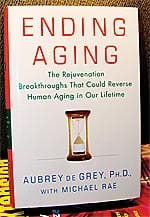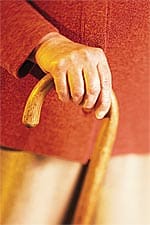Life Extension Magazine®
The book Ending Aging outlines the audacious, but highly scientific plan of Dr. Aubrey de Grey to eliminate human aging through biological engineering. No longer will humans and their loved ones be tortured with declining health, vitality, attractiveness, and ability to function by an aging process that so often ends in an agonizing and expensive death. Dr. de Grey’s Strategies for Engineered Negligible Senescence (SENS) could end aging as a cause of death within our lifetime if sufficient resources are devoted to developing the technology required. This book was written to explain how this technology can be made to work and how it could change your life. Readers of Life Extension magazine met Dr. de Grey and SENS in an interview that appeared in the February 2006 issue. Readers may have also learned of Dr. de Grey from one of his many appearances in the media or at conferences, including those he runs at Cambridge University, which attract many of the world’s foremost scientists. Given his high profile, Dr. de Grey may be the most well-known biogerontologist in the world. In fact, a recent review of Ending Aging in the Wall Street Journal1 points out that “Dr. de Grey is hardly just another fountain-of-youth huckster. He earned a PhD at Cambridge University seven years ago for his puzzle-cracking theory about how a few mutant mitochondria in our cells could cause our entire bodies to age.” Engineering RejuvenationDr. de Grey’s anti-aging strategy aims not to slow aging, but to rejuvenate by means of seven repair strategies aimed at the seven forms of cellular damage that manifest as aging. His solution seeks to clean the junk from cells (inside and out), to nullify havoc from mutations (in mitochondria and the nucleus), to eliminate protein cross-linking and to replace lost cells as well as get rid of bad cells that are causing problems. Indeed, the recent Wall Street Journal review1 concurs that, “Old age may be only the consequence of lax biological housecleaning.” Engineering an approach to repair the accumulated damage of aging defies the maxim that “prevention is better than cure.” Dr. de Grey believes that fixing damage can be much easier than trying to prevent it. The damage itself can be easy to identify, but understanding the causes of the damage in order to prevent it can be terribly difficult. Why invest heavily to slow aging by 25% when the same resources may enable people to live hundreds of years or more of healthy, youthful life?
Dr. de Grey and Mr. Rae have done a masterful job of packing enormous scientific understanding into a book of 400 pages. Even those not interested in rejuvenation can learn a great deal of sophisticated molecular biology from the lucid explanations. The authors have devoted much of their considerable imagination to finding everyday examples and analogies that greatly simplify some very complex science. Part I explains why rejuvenation is feasible and so urgent, while Part II is the scientific core of the book, with an entire chapter devoted to each one of the seven SENS strategies. The first two chapters of Part II are concerned with biochemistry related to mitochondria. Even given the impressive efforts devoted to simplification by the authors, this subject is dauntingly complex. For readers who persist, however, there is much interesting science to be learned here, as with all of Part II. Replacing Worn Out CellsDr. de Grey maintains that older tissues (including the immune system) can become clogged by inoperative old cells that sometimes produce toxic substances. The SENS solution is obvious: get rid of those cells. Fat cells in visceral (abdominal) fat may function normally, but their by-products are undesirable. These too must go. The SENS challenge is therefore to selectively target and destroy undesirable cells without harming other cells.
Most people are familiar with the idea that stem cells can potentially cure Parkinson’s disease, type 1 (juvenile, insulin-dependent) diabetes, spinal cord injuries and a host of other diseases, even recreating or rejuvenating entire organs such as the thymus. Perhaps for this reason, the chapter on stem cells is not as focused on the SENS technical agenda, but rather seeks to dispel scientific misconceptions and explain political problems regarding stem cells. One would be hard-pressed to find a more concise, detailed and clear explanation of the problems that have blocked the development of stem cell science than is contained in this chapter. The final SENS chapter of Part II deals with what many (including Dr. de Grey himself) regard as the most audacious aspect of this program: curing cancer. The goal of this strategy—to eliminate cancer cells—is the same as that of conventional medicine, but their methods differ. Unlike some biogerontologists who want to use telomerase as a life-extension strategy, Dr. de Grey wants to eliminate telomerase genes from the human genome as a means of disempowering cancer. He believes that telomerase-dependent human stem cells can be periodically replenished. In most cases, such replenishment need not occur more than every ten years. War On AgingA recent Wall Street Journal review1 of Ending Aging notes that “If there is a War on Drugs and a War on Terror, then why not a War on Aging, since these days aging kills just about everyone?” The FDA, however, does not regard aging to be a disease and will not permit clinical trials of aging interventions. Yet, most anti-aging strategies can be used to treat specific diseases, for example, protein cross-linking is a serious problem for diabetics, mitochondrial DNA in the nucleus can fix mitochondrial diseases, and stem cells can potentially treat many diseases. A more difficult problem with the FDA is that it is slow to approve drugs and clinical trials for any reason, possibly because it is readily blamed for lives lost due to such approval. However, an estimated ten times more lives are lost through slow FDA approval of safe drugs than fast approval of drugs that later prove to be unsafe. Dr. de Grey advocates political activism to remove the obstacles to rejuvenation research. He encourages financial support for his Methuselah Foundation, which grants money to researchers. And he recommends that people contribute to the Methuselah Mouse Prize, which (similar to the X Prize in space travel) rewards researchers who make breakthroughs in making a middle-aged mouse young again, thereby lengthening its lifespan.
Part III of the book also highlights the political and financial tactics to achieve the goals of SENS. It addresses the psychological, social and political obstacles to SENS―and the means to overcome them. Dr. de Grey compares current rejuvenation research with the long history of (often ludicrous) attempts at human flight before the Wright brothers. He believes that demonstrating rejuvenation in a mouse could signal a breakthrough for rejuvenation technology, just as the Wright brothers’ discovery marked a new dawn in the age of flight. Once the goals of SENS have been achieved, more repair-resistant aging problems are expected to become more prominent; however, if technological progress proceeds rapidly enough, aging as a cause of death can be eliminated. As highlighted in a recent Wall Street Journal review,1 “If even one of his proposals works, it could mean years of extended healthy living not only for unborn generations but also for those of us already casting an uneasy eye toward the mirror.” Ending Aging: The Rejuvenation Breakthroughs that Could Reverse Human Aging in Our Lifetime by Aubrey de Grey, PhD, with Michael RaeISBN: 0-312-36706-6 St Martin’s Press, publication date September 4, 2007 If you have any questions about the scientific content of this article, please call a Life Extension Health Advisor at 1-800-226-2370. | ||||
| References | ||||
| 1. Boutin P. Battling time’s ravages. A maverick biotech researcher’s goal: perpetual youth. Wall Street Journal. September 8, 2007:8. |




